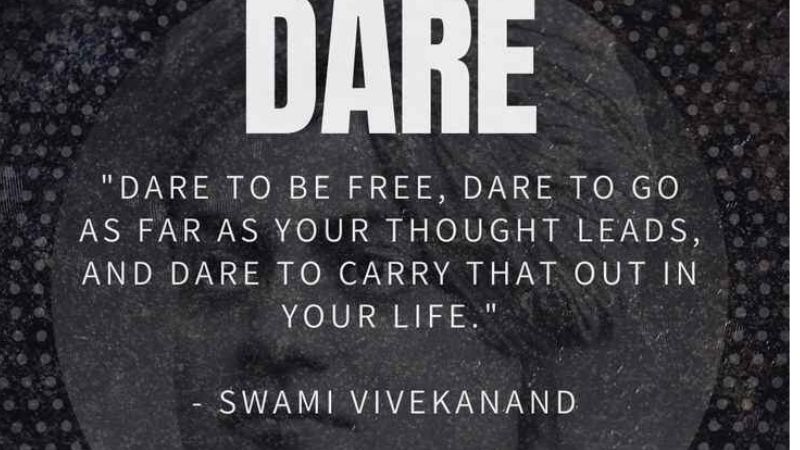Dare to Lead by Brené Brown is a transformative guide on how to embrace vulnerability, courage, and reality in leadership. Through Dare to Lead Quotes and research, Brown explains how these qualities are vital for building strong, trusting relationships and creating environments where people feel safe, valued, and empowered to contribute their best.
By prioritizing empathy and fostering a culture of connection, leaders can inspire their teams to rise to challenges and grow together.

Dare to Lead Quotes
Dare to Lead by Brené Brown redefines leadership by focusing on the importance of vulnerability, courage, and the responsibility of leaders to unlock the potential in both people and processes.
1. “I define a leader as anyone who takes responsibility for finding the potential in people and processes, and who has the courage to develop that potential.”
Explanation: This quote redefines leadership by focusing on the responsibility of leaders to identify and nurture the untapped potential in others.
It emphasizes courage as a necessary quality for leadership, encouraging growth in individuals and systems.
2. “At the end of the day, at the end of the week, at the end of my life, I want to say I contributed more than I criticized.”
Explanation: Brown highlights the importance of positivity and contribution over negativity. This quote encourages individuals to focus on making a difference rather than criticizing or pointing out faults.
3. “The courage to be vulnerable is not about winning or losing, it’s about the courage to show up when you can’t predict or control the outcome.”
Explanation: Vulnerability is not about seeking control or certainty; it’s about showing up authentically even when outcomes are uncertain. This quote urges embracing vulnerability as a source of strength.
4. “Clear is kind. Unclear is unkind.”
Explanation: Brown emphasizes that clarity in communication is essential for kindness. Being vague or unclear in communication can lead to confusion and hurt, while being clear is an act of care and respect.
5. “If you are not in the arena getting your ass kicked on occasion, I’m not interested in or open to your feedback.”
Explanation: This quote calls out those who criticize from a safe distance, not involved in the challenges. Brown stresses that only those who actively take risks and face setbacks have the credibility to offer feedback.
6. “People are opting out of vital conversations about diversity and inclusivity because they fear looking wrong, saying something wrong, or being wrong.”
Explanation: Brown calls attention to how fear of making mistakes prevents necessary discussions about diversity and inclusivity. Choosing comfort over challenging conversations creates a barrier to meaningful change.
7. “Show up for people in pain and don’t look away.”
Explanation: This quote encourages people to offer support and empathy when others are in distress. It emphasizes the importance of being present and offering compassion rather than avoiding discomfort.
8. “We fail the minute we let someone else define success for us.”
Explanation: Brown stresses the importance of defining success on your own terms. Letting others dictate what success means can lead to a life that doesn’t align with your values and aspirations.
9. “Don’t grab hurtful comments and pull them close to you by rereading them and ruminating on them.”
Explanation: This quote advises against dwelling on negative comments or criticism. It encourages people to let go of hurtful words and avoid letting them affect their emotional well-being.
10. “If we want people to fully show up, to bring their whole selves including their unarmored, whole hearts—so that we can innovate, solve problems, and serve people—we have to be vigilant about creating a culture in which people feel safe, seen, heard, and respected.”
Explanation: Brown underscores the importance of creating an environment where people feel safe to be authentic. A culture of trust and respect is necessary for creativity, problem-solving, and innovation.
11. “Daring leaders work to make sure people can be themselves and feel a sense of belonging.”
Explanation: Leaders must create spaces where individuals feel they belong and can be their true selves. This sense of belonging fosters trust and encourages people to contribute fully.
12. “The only thing I know for sure after all of this research is that if you’re going to dare greatly, you’re going to get your ass kicked at some point.”
Explanation: Brown acknowledges that choosing courage and taking risks will inevitably lead to failures and setbacks. However, these challenges are part of the journey and a necessary part of growth.
13. “It turns out that trust is in fact earned in the smallest of moments.”
Explanation: Trust is built through small, everyday actions rather than grand gestures. Brown highlights how paying attention and showing care in the little moments is essential to building strong relationships.
14. “Living BIG (boundaries, integrity, and generosity).”
Explanation: Brown encourages people to live by the principles of boundaries, integrity, and generosity. These qualities help individuals maintain a healthy and balanced life while contributing positively to others.
15. “If you have more than three priorities, you have no priorities.”
Explanation: This quote emphasizes the importance of focus. If there are too many priorities, it becomes difficult to give each one the attention it deserves. Narrowing down to a few key priorities ensures effectiveness.
“Don’t grab hurtful comments and pull them close to you by rereading them and ruminating on them. Don’t play with them by rehearsing your badass comeback. And whatever you do, don’t pull hatefulness close to your heart. Let what’s unproductive and hurtful drop at the feet of your unarmored self.”
This quote advises not to dwell on negative or hurtful comments, as doing so only strengthens self-doubt and negativity. Instead, it encourages letting go of criticism, focusing on resilience, and not allowing harmful words to affect your emotional well-being.

16. “We are not here to fit in, be well balanced, or provide exempla for others. We are here to be eccentric, different, perhaps strange, perhaps merely to add our small piece, our little clunky, chunky selves, to the great mosaic of being.”
Explanation: Brown advocates for embracing individuality and authenticity. Life isn’t about fitting in or conforming; it’s about adding your unique perspective to the world.
17. “Only when diverse perspectives are included, respected, and valued can we start to get a full picture of the world.”
Explanation: This quote stresses the importance of inclusivity. Respecting and valuing diverse perspectives enriches understanding and leads to better solutions and outcomes.
18. “Why do we insist on dress-rehearsing tragedy in moments of deep joy?”
Explanation: Brown highlights the tendency to anticipate disaster even during moments of joy, a response rooted in vulnerability. Embracing joy without fear allows us to fully appreciate the beauty of the moment.
19. “It is not the critic who counts; not the man who points out how the strong man stumbles, or where the doer of deeds could have done them better.”
Explanation: This famous quote is about valuing those who are actively involved in the work rather than critics. It highlights the importance of effort, courage, and perseverance, even in the face of failure.
20. “Feeding people half-truths or bullshit to make them feel better (which is almost always about making ourselves feel more comfortable) is unkind.”
Explanation: Brown stresses the importance of honesty, even when the truth is uncomfortable. Offering false comfort to avoid discomfort is ultimately unkind and unproductive.
21. “Neuroscientist Antonio Damasio reminds us, ‘We are not necessarily thinking machines. We are feeling machines that think.’”
Explanation: Brown emphasizes that emotions play a significant role in decision-making. Humans are driven by feelings, and understanding this can lead to more empathetic and effective leadership.
22. “Choose courage over comfort.”
Explanation: This quote encourages people to embrace discomfort and take courageous actions. True growth and change happen when we step out of our comfort zones.
23. “Rather than spending a reasonable amount of time proactively acknowledging and addressing the fears and feelings that show up during change and upheaval, we spend an unreasonable amount of time managing problematic behaviors.”
Explanation: Brown calls for a shift in focus from managing negative behaviors to addressing underlying fears and emotions. Acknowledging these feelings helps resolve issues more effectively.
24. “If you put shame in a petri dish and cover it with judgment, silence, and secrecy, you’ve created the perfect environment for shame to grow until it makes its way into every corner and crevice of your life.”
Explanation: Brown highlights how shame thrives in secrecy and judgment. By exposing it to empathy and openness, we can diminish its power over our lives.
25. “One of the signature mistakes with empathy is that we believe we can take our lenses off and look through the lenses of someone else. We can’t.”
Explanation: This quote challenges the idea that we can fully understand someone else’s experience. While we can try to understand their perspective, our own experiences shape how we see the world.
26. “So often, when someone is in pain, we’re afraid to say, ‘Yes, this hurts. Yes, this is a big deal. Yes, this sucks.’”
Explanation: Brown encourages people to acknowledge and validate others’ pain instead of trying to minimize or fix it. Recognizing the hurt is the first step toward offering true empathy.
27. “To be the person who we long to be—we must again be vulnerable. We must take off the armor, put down the weapons, show up, and let ourselves be seen.”
Explanation: True growth and authenticity come from vulnerability. Brown stresses that in order to fully engage with life, we must let go of the emotional armor and show up as our true selves.
28. “For me, that strong back is grounded confidence and boundaries. The soft front is staying vulnerable and curious.”
Explanation: Brown discusses the balance between strength and vulnerability. A confident, firm foundation is important, but so is the willingness to be vulnerable and open to learning.
29. “The Ham-Foldover Debacle:…..you make yourself the center of something that has nothing to do with you, out of your own fear or scarcity, only to be reminded that you’re not the axis over which the world turns.”
Explanation: This quote humorously highlights how fear and insecurity can cause us to overinflate our importance. It’s a reminder that the world doesn’t revolve around us, and we must remain humble.
30. “People, people, people are just people, people, people.”
Explanation: Brown’s simple reminder that everyone is human, with flaws, strengths, and vulnerabilities. It emphasizes the need for empathy and understanding when interacting with others.
31. “We define leadership as anyone who takes responsibility for finding the potential in people and processes, and who has the courage to develop that potential.”
Explanation: Leadership is about recognizing the potential in others and taking responsibility for nurturing that growth. It requires the courage to foster development, even when the process is difficult.
32. “The most significant barrier to true belonging is our fear of being vulnerable, our fear of not being enough, of being judged, and of not fitting in.”
Explanation: Brown highlights how the fear of vulnerability prevents us from truly belonging. Overcoming these fears enables us to embrace our authentic selves and find a sense of belonging.
33. “Courage starts with showing up and letting ourselves be seen.”
Explanation: True courage begins when we show up, face our fears, and allow ourselves to be vulnerable. Only then can we fully engage with the world and take risks.
34. “You cannot get to courage without rumbling with vulnerability.”
Explanation: Vulnerability is an essential part of courage. Without confronting our fears and uncertainties, we cannot summon the bravery required to face challenges.
35. “We don’t need to be perfect. We need to be brave.”
Explanation: This quote encourages embracing bravery over perfection. True leadership and personal growth come from courage, not from being flawless or without fear.
36. “Vulnerability is not winning or losing; it’s having the courage to show up and be seen when we have no control over the outcome.”
Explanation: Vulnerability is about being open and authentic, even when we cannot predict or control what will happen. It requires the courage to expose ourselves without knowing the result.
37. “When we stop being afraid of failure, we start being brave enough to succeed.”
Explanation: Fear of failure holds us back from reaching our full potential. Once we accept failure as part of growth, we can become brave enough to succeed and take bold actions.
38. “Courage is not about being fearless. It’s about taking action despite your fear.”
Explanation: Courage isn’t the absence of fear; it’s the ability to act even when we’re afraid. Taking action, regardless of fear, is what allows us to grow and lead effectively.
39. “Daring leaders are those who have the courage to be vulnerable, to lead with their whole hearts, and to engage in the work of brave conversations.”
Explanation: Daring leadership is about being vulnerable, open, and engaged in difficult conversations. It takes courage to lead with authenticity and take on challenges with integrity.
40. “We are all afraid of something. The key is not to let fear dictate our choices, our actions, or our future.”
Explanation: Fear is natural, but it should not control our decisions. Instead, we must face our fears and move forward with intention, ensuring they don’t hold us back from achieving our goals.
41. “Daring leadership is not about being fearless. It’s about having the courage to take action even in the presence of fear.”
Explanation: Leadership requires action despite fear. The essence of daring leadership is pushing forward even when fear is present, rather than waiting for fear to disappear.
42. “Vulnerability is the birthplace of innovation, creativity, and change.”
Explanation: Embracing vulnerability creates space for new ideas, growth, and transformation. Innovation and creativity thrive when we allow ourselves to be open and take risks.
43. “In order to lead, we must first take care of ourselves.”
Explanation: Self-care is essential for effective leadership. To lead others well, we must first prioritize our own well-being, as burnout and neglect can undermine our ability to serve others.
44. “To love and be loved is the most vulnerable thing we do.”
Explanation: Love requires vulnerability because it involves emotional exposure. Being open to love means risking hurt, but it also brings connection and growth.
45. “We can’t practice courage and be comfortable at the same time.”
Explanation: Courage requires stepping out of our comfort zones. True growth and change happen when we are willing to embrace discomfort and face challenges head-on.
46. “Daring to set boundaries is about having the courage to love ourselves, even when we risk disappointing others.”
Explanation: Setting boundaries requires courage and self-love. By setting limits, we prioritize our well-being, even at the risk of disappointing those around us.
47. “Leaders are not afraid to say, ‘I don’t know.’”
Explanation: Strong leaders embrace humility and the power of vulnerability. Admitting when we don’t know something allows for learning, growth, and honest collaboration.
48. “The only way to do great work is to love what you do.”
Explanation: Passion is the driving force behind excellence. When we love what we do, it fuels dedication and creativity, enabling us to produce our best work.
49. “Bravery is the ability to move forward, to act, even when we are scared.”
Explanation: Bravery is taking action despite fear. It involves continuing to push ahead even when we feel uncertain or afraid, trusting that we can overcome challenges.
50. “We don’t have to be perfect to be brave.”
Explanation: Perfection is not required to show courage. What matters is the willingness to take risks, make mistakes, and learn from them, which is the essence of bravery.
51. “Empathy fuels connection. Sympathy drives disconnection.”
Explanation: Empathy fosters understanding and bonding, while sympathy can create distance by positioning oneself above others. True connection comes from empathizing with someone’s experiences.
52. “The most important thing we can do is to be kind to ourselves.”
Explanation: Self-compassion is vital for well-being. When we treat ourselves with kindness, it strengthens our emotional resilience and allows us to be more effective in our relationships with others.
53. “We are at our best when we are brave enough to be vulnerable, to be open to feedback, and to challenge ourselves to grow.”
Explanation: True growth occurs when we embrace vulnerability, seek feedback, and challenge ourselves. This openness enables continuous improvement and stronger leadership.
54. “Connection is why we’re here; it is what gives purpose and meaning to our lives.”
Explanation: Connection is fundamental to human existence. Building meaningful relationships and bonds with others gives life depth and direction.
55. “Our courage is contagious. When we choose courage, we inspire others to choose it too.”
Explanation: Courage has a ripple effect. When we act boldly and choose courage, it inspires those around us to do the same, creating a culture of bravery and resilience.
56. “Trust is built in very small moments.”
Explanation: Trust is earned through consistent, everyday actions rather than grand gestures. Small moments of care and integrity add up to form strong, lasting trust.
57. “We cannot lead others without first leading ourselves.”
Explanation: Leadership starts with self-leadership. Before we can effectively guide others, we must first learn to manage our own thoughts, actions, and emotions.
58. “To be truly courageous, we must be willing to fail.”
Explanation: Courage involves taking risks and being willing to fail. Failure is an inevitable part of growth and bravery, and accepting it leads to progress.
59. “Vulnerability is the core of all emotions and feelings. To be human is to be vulnerable.”
Explanation: Vulnerability is at the heart of human experiences. Emotions like love, joy, and fear are all rooted in our ability to be vulnerable, making it an essential part of our lives.
60. “There’s no innovation and creativity without failure. Period.”
Explanation: Failure is a necessary component of innovation. Without failure, there is no room for growth, experimentation, or creativity.
61. “Empathy is a choice. And it’s a vulnerable choice, because if I were to choose to connect with you through empathy, I would have to connect with something in myself that knows that feeling.”
Explanation: Empathy requires vulnerability, as it means opening ourselves to others’ pain by connecting to our own experiences. It’s not just about fixing problems but sitting with someone in their discomfort.
62. “We asked a thousand leaders to list marble-earning behaviors—what do your team members do that earns your trust? The most common answer: asking for help.”
Explanation: Asking for help is seen as a trust-building behavior, signaling vulnerability and the willingness to learn. Leaders appreciate those who can admit when they need support, fostering better teamwork.
63. “We have to be able to take feedback—regardless of how it’s delivered—and apply it productively. Mastery requires feedback.”
Explanation: Mastery in any field is impossible without feedback. Brown emphasizes the importance of being open to criticism, regardless of its delivery, to improve and grow.
64. “I always bring my core values to feedback conversations. I specifically bring courage, which means that I don’t choose comfort over being respectful and honest.”
Explanation: Courage in feedback means being honest, even if it’s uncomfortable. Brown believes that being respectful and truthful, rather than polite, leads to more meaningful and productive conversations.
65. “In a 1968 speech given to striking sanitation workers in Memphis, Reverend Martin Luther King, Jr., defined power as the ability to achieve purpose and effect change.”
Explanation: King’s definition of power aligns with Brown’s perspective: true power lies in the ability to drive change and fulfill a greater purpose. It’s not about control, but impact.
66. “In the end, the cure for numbing is developing tools and practices that allow you to lean into discomfort and renew your spirit.”
Explanation: Numbing, or avoiding discomfort, only worsens the situation. The cure lies in developing practices that help us face and work through discomfort, leading to emotional renewal and growth.
67. “I know I’m living outside my values when I am…resentful. Resentment is my barometer and my early warning system.”
Explanation: Brown uses resentment as a signal that she’s not living in alignment with her values. It’s a reminder to reassess decisions and behaviors before resentment takes hold.
68. “A brave leader is someone who says I see you. I hear you. I don’t have all the answers, but I’m going to keep listening and asking questions.”
Explanation: True leadership involves actively listening, acknowledging others, and being humble. A brave leader doesn’t claim to have all the answers but commits to understanding and seeking solutions.
69. “I’m also not a fan of anything that’s brutal, including honesty. Honesty is the best policy, but honesty that’s motivated by shame, anger, fear, or hurt is not ‘honesty.’”
Explanation: Honesty should be driven by respect and compassion, not negative emotions. Brown warns against using “honesty” as an excuse to hurt others, masking it with harmful intentions.
70. “If I share something with you that’s difficult for me, I’d rather you say, ‘I don’t even know what to say right now, I’m just so glad you told me.’”
Explanation: Sometimes, words can’t fix the pain others feel. Brown highlights the importance of simply being present and acknowledging the courage it took for someone to open up.
71. “What we are ethically called to do, is create a space in our schools and classrooms where all students can walk in and take off the crushing weight of their armor.”
Explanation: Brown advocates for creating safe spaces where students can be their authentic selves. When people feel accepted, free from judgment, and unburdened, they can fully engage and thrive.
72. “Self-compassion is an easy list to write, and a hard list to live. For me, it’s all about sleep, healthy food, exercise, and connection.”
Explanation: Self-compassion is not just an abstract idea; it involves daily practices that support physical, emotional, and social well-being. Brown shares that self-care is a continual effort, not a one-time thing.
73. “Shame is not a compass for moral behavior. It’s much more likely to drive destructive, hurtful, immoral, and self-aggrandizing behavior than it is to heal it.”
Explanation: Shame often leads to harmful actions rather than moral growth. Brown explains that the absence of empathy, rather than the presence of shame, is what breeds unethical behavior.
74. “Shame is the fear of disconnection—it’s the fear that something we’ve done or failed to do makes us unworthy of love, belonging, and connection.”
Explanation: Shame makes us feel unworthy of connection. It stems from believing we are flawed, which leads to isolation and emotional pain, preventing us from fully engaging in relationships.
75. “Shame is universal and one of the most primitive human emotions that we experience. The only people who don’t experience shame are those who lack the capacity for empathy and human connection.”
Explanation: Shame is a fundamental emotion shared by all humans, tied to our need for empathy and connection. Those who lack this capacity do not experience shame, highlighting its link to emotional intelligence.
76. “When our organization rewards armoring behaviors like blaming, shaming, cynicism, perfectionism, and emotional stoicism, we can’t expect innovative work.”
Explanation: Rewarding defensive behaviors, like blaming and perfectionism, stifles innovation. Brown highlights that creative work can’t thrive in an environment where people are shielded by emotional armor.
77. “Don’t grab hurtful comments and pull them close to you by rereading them and ruminating on them. Let what’s unproductive and hurtful drop at the feet of your unarmored self.”
Explanation: Brown urges us to let go of hurtful criticism. Dwelling on negative comments only strengthens our doubts, while releasing them allows us to move forward with more freedom and clarity.
78. “It’s simple but transformative: Clear is kind. Unclear is unkind.”
Explanation: Clarity in communication is an act of kindness. When we are unclear, we risk causing confusion and frustration, whereas clear communication fosters understanding and trust.
79. “At work, foreboding joy often shows up in more subtle and pernicious ways. It shows up by making us hesitant to celebrate victories, for two primary reasons.”
Explanation: Foreboding joy makes us hesitant to celebrate accomplishments, fearing disaster or complacency. Brown identifies this as a damaging mindset that prevents us from fully enjoying success.
80. “Leaders must either invest a reasonable amount of time attending to fears and feelings, or squander an unreasonable amount of time trying to manage ineffective and unproductive behavior.”
Explanation: Leaders who ignore emotions and fears will face more difficulties in managing behavior. Brown advocates for addressing underlying emotions, as it leads to more productive and effective leadership.
81. “Mastery requires feedback.”
Explanation: Growth and proficiency in any skill require ongoing feedback. Brown emphasizes that feedback is essential for improvement, whether in personal development or professional mastery.
82. “Trust is, in fact, earned in the smallest of moments.”
Explanation: Trust is built through small, consistent actions. Brown explains that trust isn’t earned through grand gestures, but by showing care and reliability in everyday moments.
83. “There’s probably not a single act at work that requires more vulnerability than holding people responsible for ethics and values, especially when you’re alone in it.”
Explanation: Holding others accountable for ethics and values requires vulnerability, especially when standing alone. Brown stresses that it takes immense courage to make ethical decisions when faced with opposition.
84. “If you are not in the arena getting your ass kicked on occasion, I’m not interested in or open to your feedback.”
Explanation: Brown warns against taking feedback from those who are not actively involved in the process. Only those who face challenges and risks firsthand have the credibility to offer valuable advice.
85. “This making up stories and conspiracy theories is something we all do. Gottschall writes, ‘Conspiracy is not limited to the stupid, the ignorant, or the crazy. It is a reflex of the storytelling mind’s compulsive need for meaningful experience.’”
Explanation: Our minds often create stories or conspiracy theories to make sense of uncertainty. Brown explains that, rather than confronting vulnerability, we tend to fill in the blanks with fearful narratives.
86. “Silence is not brave leadership, and silence is not a component of brave cultures.”
Explanation: Silence in the face of injustice or issues is not courageous leadership. Brown emphasizes that brave leaders must speak up, even when it’s uncomfortable, to create cultures of accountability and transparency.
87. “The trickiest barrier to empathy? Take a look in the mirror. Being kind and extending the hypothesis of generosity to ourselves when we mess up is the first step.”
Explanation: The hardest part of empathy is extending it to ourselves. When we make mistakes, showing kindness and generosity toward ourselves is the first step in truly understanding others’ experiences.
88. “In our political chaos, people throw around the word shameless when they see someone make a self-serving or unethical decision.”
Explanation: Brown explains that calling someone “shameless” in the context of unethical behavior is misleading. Often, shame is at the root of self-serving actions, not a lack of it.
89. “Acknowledge and reward great questions and instances of ‘I don’t know, but I’d like to find out’ as daring leadership behaviors.”
Explanation: Leaders should value curiosity and openness to learning. By rewarding the willingness to question and seek answers, they foster a culture of growth and continuous improvement.
90. “Also have a new meeting minutes process. Everyone takes their own notes, but one person in the meeting volunteers to capture minutes.”
Explanation: Brown introduces a new practice to improve meeting productivity: everyone contributes to note-taking, and the minutes are reviewed at the end. This approach ensures clarity and accountability, streamlining team communication.
91. “Empathy is a choice. And it’s a vulnerable choice, because if I were to choose to connect with you through empathy, I would have to connect with something in myself that knows that feeling.”
Explanation: Empathy requires us to recognize our own vulnerabilities and connect with others on an emotional level. It’s about embracing discomfort in order to show understanding, not just fixing problems.
92. “We asked a thousand leaders to list marble-earning behaviors—what do your team members do that earns your trust? The most common answer: asking for help.”
Explanation: Trust is earned when team members ask for help, showing vulnerability and a willingness to collaborate. Leaders value people who seek support rather than pretending to have all the answers.
93. “We have to be able to take feedback—regardless of how it’s delivered—and apply it productively. Mastery requires feedback.”
Explanation: Brown highlights the necessity of feedback for growth. Mastery in any area, whether personal or professional, requires the humility and openness to receive constructive criticism and use it to improve.

94. “I always bring my core values to feedback conversations. I specifically bring courage, which means that I don’t choose comfort over being respectful and honest—choosing politeness over respect is not respectful.”
Explanation: In feedback conversations, Brown emphasizes the importance of being honest and respectful, even if it’s uncomfortable. Courage allows us to prioritize honesty over avoiding difficult truths.
95. “In a 1968 speech given to striking sanitation workers in Memphis, Reverend Martin Luther King, Jr., defined power as the ability to achieve purpose and effect change. This is the most accurate and important definition of power that I’ve ever seen.”
Explanation: Brown reflects on MLK’s definition of power: the ability to make a difference and drive change. She stresses that true power is rooted in its purpose and its impact on others.
96. “In the end, the cure for numbing is developing tools and practices that allow you to lean into discomfort and renew your spirit.”
Explanation: Numbing emotions through distractions or avoidance doesn’t solve underlying issues. Brown advocates for embracing discomfort and creating strategies to restore emotional balance and resilience.
97. “I know I’m living outside my values when I am…resentful. Resentment is my barometer and my early warning system.”
Explanation: Resentment signals when we are not living in alignment with our values. Brown uses it as a personal alert system, reminding us to reflect and course-correct when resentment arises.
98. “A brave leader is someone who says I see you. I hear you. I don’t have all the answers, but I’m going to keep listening and asking questions.”
Explanation: Brown defines brave leadership as the willingness to listen, acknowledge others, and stay humble. Brave leaders engage with others by recognizing their needs and continuously seeking understanding.
99. “I’m also not a fan of anything that’s brutal, including honesty. Honesty is the best policy, but honesty that’s motivated by shame, anger, fear, or hurt is not ‘honesty.'”
Explanation: Honesty should not come from a place of negative emotions such as anger or shame. Brown highlights that true honesty is grounded in care and respect, not in causing harm or airing grievances.
100. “If I share something with you that’s difficult for me, I’d rather you say, ‘I don’t even know what to say right now, I’m just so glad you told me.’”
Explanation: Sometimes, when someone shares something vulnerable, the best response is simply to listen and acknowledge their courage. Brown emphasizes that connection and empathy are more healing than trying to fix the situation.
101. “What we are ethically called to do, is create a space in our schools and classrooms where all students can walk in and take off the crushing weight of their armor.”
Explanation: Brown advocates for creating safe spaces in schools where students can be their authentic selves, free from fear and judgment. This environment promotes learning, creativity, and personal growth.
102. “Self-compassion is an easy list to write, and a hard list to live. For me, it’s all about sleep, healthy food, exercise, and connection.”
Explanation: Practicing self-compassion requires consistent effort in taking care of physical, emotional, and social well-being. Brown reminds us that it’s easy to talk about self-care, but much harder to live it out consistently.
103. “Shame is not a compass for moral behavior. It’s much more likely to drive destructive, hurtful, immoral, and self-aggrandizing behavior than it is to heal it.”
Explanation: Shame often leads to negative actions rather than moral improvement. Brown explains that empathy, not shame, is necessary for healing and positive behavior change.
104. “Shame is the fear of disconnection—it’s the fear that something we’ve done or failed to do makes us unworthy of love, belonging, and connection.”
Explanation: Shame stems from a fear of being unworthy of connection. It makes us believe that our mistakes or failures have permanently severed our ability to belong, which is deeply isolating.
105. “Shame is universal and one of the most primitive human emotions that we experience.”
Explanation: Shame is an innate emotion that all humans experience, but it becomes toxic when not addressed with empathy. Brown emphasizes that experiencing shame is natural but should be dealt with compassion.
106. “When our organization rewards armoring behaviors like blaming, shaming, cynicism, perfectionism, and emotional stoicism, we can’t expect innovative work.”
Explanation: Organizations that encourage defensive behaviors prevent creativity and innovation. Brown warns that a culture of blame and perfectionism stifles growth and undermines effective teamwork.
107. “Don’t grab hurtful comments and pull them close to you by rereading them and ruminating on them.”
Explanation: Brown advises not to internalize hurtful comments, as doing so only perpetuates negativity. Instead, let go of unproductive criticism and focus on moving forward with courage.
108. “It’s simple but transformative: Clear is kind. Unclear is unkind.”
Explanation: Clarity is a form of kindness. When we communicate clearly, we show respect and understanding, while unclear communication can lead to confusion and frustration.
109. “At work, foreboding joy often shows up in more subtle and pernicious ways.”
Explanation: Foreboding joy is the fear that something bad will follow after success. Brown explains that this mindset prevents people from celebrating achievements and can create an atmosphere of constant anxiety at work.
110. “Leaders must either invest a reasonable amount of time attending to fears and feelings, or squander an unreasonable amount of time trying to manage ineffective and unproductive behavior.”
Explanation: Leaders need to address fears and emotions proactively, or they risk dealing with negative behaviors that stem from unresolved feelings. Brown highlights the importance of emotional intelligence in leadership.
111. “Mastery requires feedback.”
Explanation: Continuous feedback is essential for mastery. Brown stresses that no matter the field, feedback is necessary to improve and reach proficiency.
112. “Trust is, in fact, earned in the smallest of moments.”
Explanation: Trust is built through consistent actions in everyday moments. Brown explains that reliability and care in small, regular interactions foster trust more than grand gestures.
113. “There’s probably not a single act at work that requires more vulnerability than holding people responsible for ethics and values, especially when you’re alone in it.”
Explanation: Holding others accountable for ethical behavior requires immense vulnerability. Brown emphasizes the courage it takes to make ethical decisions when faced with pressure or isolation.
114. “If you are not in the arena getting your ass kicked on occasion, I’m not interested in or open to your feedback.”
Explanation: Brown stresses that only those who are actively involved in the process, facing challenges and setbacks, have the right to give feedback. Criticism from those who avoid the arena is not valuable.
115. “This making up stories and conspiracy theories is something we all do.”
Explanation: Our minds often create stories to make sense of uncertainty. Brown highlights that instead of embracing vulnerability and uncertainty, we sometimes fill gaps with negative narratives and worst-case scenarios.
116. “Silence is not brave leadership, and silence is not a component of brave cultures.”
Explanation: Silence in the face of challenges or injustice is not leadership. Brown emphasizes that courageous leaders must speak up, fostering a culture of openness and accountability.
117. “The trickiest barrier to empathy? Take a look in the mirror. Being kind and extending the hypothesis of generosity to ourselves when we mess up is the first step.”
Explanation: Self-compassion is the first step in being empathetic toward others. Brown highlights the difficulty of showing kindness to ourselves, but it’s essential for cultivating empathy.
118. “In our political chaos, people throw around the word shameless when they see someone make a self-serving or unethical decision.”
Explanation: Brown argues that shame often fuels unethical behavior rather than preventing it. She explains that shame is the driving force behind narcissistic actions and ethical missteps.
119. “Acknowledge and reward great questions and instances of ‘I don’t know, but I’d like to find out’ as daring leadership behaviors.”
Explanation: Brown advocates for valuing curiosity and the willingness to learn. Acknowledging the courage to ask questions shifts focus from being right to getting it right, fostering a growth mindset.
120. “Also have a new meeting minutes process. Everyone takes their own notes, but one person in the meeting volunteers to capture minutes.”
Explanation: Brown shares a process for improving meeting effectiveness. By distributing note-taking responsibilities and reviewing minutes collaboratively, meetings become more organized and focused on action items.
121. “Stayed connected, I stayed courageous, I stayed authentic, I stayed curious, then that itself is daring, and that in itself is a win.”
Explanation: Brown emphasizes that the act of staying true to oneself and maintaining courage in the face of challenges is itself a victory. Being authentic and curious in difficult situations is a form of leadership and courage.
122. “To grow to adulthood as a social species, including humans, is not to become autonomous and solitary, it’s to become the one on whom others can depend.”
Explanation: Brown reminds us that growth is about building connections and becoming dependable for others, not about isolating ourselves. True maturity involves interdependence and the ability to support others.
123. “The more grounded confidence parents have, the more likely they are to prepare their child for the path by teaching courage, praising effort, and modeling grit, versus trying to prepare a perfect path for their child by fixing, praising only results.”
Explanation: Brown stresses the importance of modeling courage and effort over focusing solely on results. Grounded confidence in parents helps children learn resilience and perseverance, rather than relying on external validation.
124. “As the theologian Rob Bell explains, ‘Despair is the belief that tomorrow will be just like today.’ That is a devastating line.”
Explanation: Despair occurs when we believe there is no hope for change. Brown shares this powerful quote to highlight how a lack of change or growth can lead to feelings of hopelessness.
125. “Integrity is choosing courage over comfort; it’s choosing what’s right over what’s fun, fast, or easy; and it’s practicing your values, not just professing them.”
Explanation: Integrity involves doing what is right even when it’s difficult. It requires courage to practice our values consistently, even when it’s easier to avoid discomfort or take shortcuts.
126. “Let’s look at the seven elements. Some are very straightforward and some require unpacking, which I’ll do after the list…”
Explanation: This quote introduces key elements of building trust, like boundaries, reliability, and accountability. Brown emphasizes that these are essential to creating strong, authentic relationships.
127. “We want people to share our commitment to purpose and mission, not to comply because they’re afraid not to.”
Explanation: Brown advocates for creating a culture where commitment to purpose comes from inspiration, not fear. Leaders who motivate through trust and shared goals foster greater engagement and creativity.
128. “The armor of compliance and control is normally about fear and power. When we come from this place, we often engage in two armored behaviors…”
Explanation: Brown explains how a culture of control and compliance often stems from fear and power. This leads to stifled creativity and disengagement, as people are pressured to conform instead of contribute freely.
129. “The irony across all self-protection is that at the same time as we’re worrying about machine learning and artificial intelligence taking jobs and dehumanizing work…”
Explanation: Brown highlights the paradox of fearing technology’s dehumanizing effect while simultaneously creating workplaces that suppress human qualities like vulnerability and empathy, which are irreplaceable by machines.
130. “I gave him a nervous smile and said ‘Say more.’ Another favorite rumble tool. Asking someone to ‘say more’ often leads to profoundly deeper and more productive rumbling.”
Explanation: Brown shares the importance of asking people to elaborate, as it encourages deeper, more meaningful conversations. By seeking more context, we can foster better understanding and problem-solving.
131. “Globoforce worked with Cisco to use recognition to boost employee engagement by 5 percent, and with Intuit to achieve and sustain a double-digit increase in employee engagement…”
Explanation: Brown illustrates how recognition positively impacts employee engagement and satisfaction. Celebrating small victories boosts morale and creates a culture of appreciation and motivation.
132. “Because joy is the most vulnerable emotion we feel. And that’s saying something, given that I study fear and shame.”
Explanation: Brown explains that joy is often the most vulnerable emotion because it involves gratitude and impermanence. Our fear of losing it can lead us to protect ourselves by avoiding joy.
133. “I define a leader as anyone who takes responsibility for finding the potential in people and processes, and who has the courage to develop that potential.”
Explanation: Leadership, according to Brown, is about identifying and nurturing potential in others. It requires the courage to develop individuals and processes, fostering growth and improvement.
134. “Curiosity is unruly. It doesn’t like rules, or, at least, it assumes that all rules are provisional, subject to the laceration of a smart question nobody has yet thought to ask.”
Explanation: Brown describes curiosity as disruptive and unconfined by established rules. It challenges the status quo and seeks new ways of understanding and approaching problems.
135. “Somewhere along the way, they adopted this dangerous and debilitating belief system: I am what I accomplish and how well I accomplish it.”
Explanation: Brown critiques the harmful belief that self-worth is tied to achievements. This mindset leads to perfectionism, where people measure their value solely by what they do, rather than who they are.
136. “To the conspiratorial mind, shit never just happens.”
Explanation: Brown points out how some people create elaborate explanations for events, driven by fear or uncertainty. Rather than accepting randomness, they invent complex stories to make sense of the world.
137. “A brave leader is not someone who is armed with all the answers.”
Explanation: A brave leader admits that they don’t have all the answers. Instead of pretending to know everything, they approach leadership with humility and a willingness to learn.
138. “Build a culture of trust.”
Explanation: Trust is the foundation of any successful organization or relationship. Brown stresses the importance of intentionally creating an environment where trust can flourish.
139. “We do that by numbing and taking the edge off the pain with whatever provides the quickest relief.”
Explanation: Brown discusses how people often numb their emotions with temporary distractions such as alcohol or work. This avoidance doesn’t resolve the underlying issues but merely provides momentary relief.
140. “Harriet Lerner teaches, to listen with the same passion with which we want to be heard.”
Explanation: Listening with empathy and understanding is just as important as expressing ourselves. Brown encourages us to listen deeply, with the same energy we seek when sharing our own thoughts.
141. “Choosing our own comfort over hard conversations is the epitome of privilege, and it corrodes trust and moves us away from meaningful and lasting change.”
Explanation: Brown points out that avoiding difficult conversations in favor of comfort is a sign of privilege. This avoidance weakens trust and hinders real progress on important issues.
142. “In the Gifts of Imperfection, I define ten guideposts for wholehearted living…”
Explanation: Brown outlines essential guideposts for living wholeheartedly, such as authenticity, self-compassion, creativity, and meaningful work. These guideposts help us embrace imperfection and lead fulfilling lives.
143. “In the past, jobs were about muscles, now they’re about brains, but in the future they’ll be about the heart.”
Explanation: Brown shares a quote about how the future of work will depend more on emotional intelligence, empathy, and human connection than on intellectual ability or physical labor.
144. “Choose courage, you will absolutely know failure, disappointment, setback, even heartbreak. That’s why we call it courage. That’s why it’s so rare.”
Explanation: Choosing courage means facing the possibility of failure and hardship. Brown emphasizes that courage is rare because it requires us to embrace vulnerability and the potential for emotional pain.
145. “Choosing to own our vulnerability and do it consciously means learning how to rumble with this emotion and understand how it drives our thinking and behavior…”
Explanation: Brown explains that being vulnerable means recognizing and confronting our emotions, rather than avoiding them. By doing so, we can stay true to our values and make better decisions.
146. “Help us create a culture of belonging at work.”
Explanation: Brown advocates for creating environments where people feel truly connected and valued. A culture of belonging encourages collaboration and trust, essential for effective teams and organizations.
147. “Here are some specific rumble starters and questions that we use…”
Explanation: Brown provides practical tools for engaging in difficult conversations, or “rumbling,” including questions that promote deeper understanding. These tools help create more meaningful and productive dialogues.
148. “Going back to that filter of susceptibility to shame- when it comes to work, we’re afraid of being judged for a lack of knowledge or lack of understanding.”
Explanation: Brown highlights how fear of judgment prevents people from asking for help, which in turn affects trust and productivity. Vulnerability is essential for creating open, supportive work environments.
149. “I am a traveler, not a mapmaker. I am going down this path same as and with you.”
Explanation: Brown positions herself as a fellow learner, not an expert with all the answers. Leadership is about walking the path alongside others, not dictating the journey from above.
150. “Empathy is not connecting to an experience, it’s connecting to the emotions that underpin an experience.”
Explanation: Brown clarifies that empathy is about understanding the emotions behind someone’s experience, not simply relating to the situation itself. This deeper connection fosters more meaningful support.
151. “Stayed connected, I stayed courageous, I stayed authentic, I stayed curious,” then that itself is daring, and that in itself is a win.”
Explanation: Brown emphasizes that simply maintaining authenticity and curiosity in challenging situations is a significant accomplishment. It’s not about having all the answers but staying true to oneself despite the difficulties.
152. “To grow to adulthood as a social species, including humans, is not to become autonomous and solitary, it’s to become the one on whom others can depend.”
Explanation: Brown highlights that true adulthood is about interdependence, not independence. It’s about being someone others can rely on, demonstrating emotional connection and responsibility in social relationships.
153. “The more grounded confidence parents have, the more likely they are to prepare their child for the path by teaching courage, praising effort, and modeling grit, versus trying to prepare a perfect path for their child by fixing, praising only results.”
Explanation: Brown stresses that grounded confidence in parents allows them to focus on teaching resilience and effort rather than shielding their children from challenges. This approach helps children develop inner strength and perseverance.
154. “As the theologian Rob Bell explains, ‘Despair is the belief that tomorrow will be just like today.’ That is a devastating line.”
Explanation: Brown shares a profound insight that despair arises from the belief that nothing will change. When we lose hope in progress, we lose the motivation to keep pushing forward.
“Dare to be free, dare to go far, dare to dream, dare to fail, dare to live, and dare to lead.”
This quote encourages embracing freedom, boldness, and the willingness to take risks in order to achieve personal growth and success. It emphasizes the importance of dreaming big, accepting failure as part of the journey, and leading with courage and authenticity.

155. “Integrity is choosing courage over comfort; it’s choosing what’s right over what’s fun, fast, or easy; and it’s practicing your values, not just professing them.”
Explanation: Integrity involves acting with courage and staying true to your values, even when it’s uncomfortable or inconvenient. It’s about aligning actions with beliefs, not just talking about them.
156. “Let’s look at the seven elements. Some are very straightforward and some require unpacking…”
Explanation: This quote introduces key elements of trust-building, such as boundaries, reliability, and accountability. Brown explains how these elements lay the foundation for strong relationships and teamwork.
157. “We want people to share our commitment to purpose and mission, not to comply because they’re afraid not to.”
Explanation: Brown discusses the difference between compliance driven by fear and commitment driven by shared purpose. Leaders should inspire commitment to the mission, not just enforce compliance through fear.
158. “The armor of compliance and control is normally about fear and power.”
Explanation: Brown argues that when leadership is based on fear and control, it reduces people’s work to mere tasks. This approach stifles creativity and collaboration, leading to disengagement and dissatisfaction.
159. “The irony across all self-protection is that at the same time as we’re worrying about machine learning and artificial intelligence taking jobs…”
Explanation: Brown points out the contradiction between fearing machines replacing human roles while simultaneously creating cultures that suppress human qualities like empathy and vulnerability, which machines can never replicate.
160. “I gave him a nervous smile and said ‘Say more.’ Another favorite rumble tool. Asking someone to ‘say more’ often leads to profoundly deeper and more productive rumbling.”
Explanation: Brown encourages asking people to elaborate during tough conversations. This simple technique often leads to deeper understanding and allows for more meaningful dialogue.
161. “Globoforce worked with Cisco to use recognition to boost employee engagement by 5 percent…”
Explanation: Brown uses examples of how recognition programs improve employee engagement and satisfaction. Celebrating small victories fosters an atmosphere of appreciation and motivation, which enhances performance.
162. “Because joy is the most vulnerable emotion we feel. And that’s saying something, given that I study fear and shame.”
Explanation: Brown explores the vulnerability associated with joy. It involves a deep sense of gratitude and impermanence, which makes it difficult for people to fully embrace without fear of loss or hurt.
163. “I define a leader as anyone who takes responsibility for finding the potential in people and processes, and who has the courage to develop that potential.”
Explanation: Brown defines leadership as a role that involves discovering and nurturing potential in others, which requires courage. Leaders are responsible for helping people and processes evolve and grow.
164. “Curiosity is unruly. It doesn’t like rules, or, at least, it assumes that all rules are provisional, subject to the laceration of a smart question nobody has yet thought to ask.”
Explanation: Brown describes curiosity as rebellious and free-spirited. It challenges the status quo and questions existing norms, which is essential for innovation and problem-solving.
165. “Somewhere along the way, they adopted this dangerous and debilitating belief system: I am what I accomplish and how well I accomplish it.”
Explanation: Brown critiques the harmful belief that self-worth is tied to achievement. This mindset leads to perfectionism, where individuals define themselves by their success, rather than their intrinsic value.
166. “To the conspiratorial mind, shit never just happens.”
Explanation: Brown highlights how some people construct elaborate explanations to make sense of uncertain situations. They often fill gaps with fears and worst-case scenarios instead of accepting that things may just happen randomly.
167. “A brave leader is not someone who is armed with all the answers.”
Explanation: Brown stresses that brave leadership is about embracing uncertainty and showing vulnerability. Leaders who acknowledge their limitations create a culture of openness and collaboration.
168. “Build a culture of trust.”
Explanation: Trust is the cornerstone of effective leadership and teamwork. Brown emphasizes the importance of cultivating trust within organizations to foster collaboration and innovation.
169. “We do that by numbing and taking the edge off the pain with whatever provides the quickest relief.”
Explanation: Brown explains how people often numb their emotions through distractions like work or substance use. While these methods may offer temporary relief, they don’t address the underlying issues.
170. “Harriet Lerner teaches, to listen with the same passion with which we want to be heard.”
Explanation: Brown underscores the importance of active listening. To truly connect with others, we must listen with empathy and attention, just as we expect others to listen to us.
171. “Choosing our own comfort over hard conversations is the epitome of privilege, and it corrodes trust and moves us away from meaningful and lasting change.”
Explanation: Brown calls out the privilege of avoiding difficult conversations. Choosing comfort over addressing tough issues weakens trust and prevents real progress and change.
172. “In the Gifts of Imperfection, I define ten guideposts for wholehearted living…”
Explanation: Brown provides ten principles for living authentically and fully. These guideposts focus on embracing imperfection and living a life guided by values such as creativity, self-compassion, and gratitude.
173. “In the past, jobs were about muscles, now they’re about brains, but in the future they’ll be about the heart.”
Explanation: Brown reflects on how the future of work will rely more on emotional intelligence, empathy, and human connection than on intellectual or physical labor.
174. “Choose courage, you will absolutely know failure, disappointment, setback, even heartbreak. That’s why we call it courage.”
Explanation: Brown reminds us that courage involves facing failure and disappointment. True courage lies in choosing to act despite the fear of emotional pain or failure.
175. “Choosing to own our vulnerability and do it consciously means learning how to rumble with this emotion and understand how it drives our thinking and behavior…”
Explanation: Embracing vulnerability means being conscious of how our emotions influence our thoughts and actions. It requires self-awareness and a willingness to stay aligned with our values despite emotional discomfort.
176. “Help us create a culture of belonging at work.”
Explanation: Brown advocates for building a workplace where everyone feels included and valued. A culture of belonging leads to greater engagement, collaboration, and overall success.
177. “Here are some specific rumble starters and questions that we use…”
Explanation: Brown provides practical questions for engaging in difficult conversations. These “rumble starters” encourage clarity, openness, and a deeper understanding of the issues at hand.
178. “Going back to that filter of susceptibility to shame- when it comes to work, we’re afraid of being judged for a lack of knowledge or lack of understanding.”
Explanation: Brown highlights the fear of judgment in the workplace, which often prevents people from asking for help. This fear of vulnerability can create a culture of silence, hindering growth and collaboration.
179. “I am a traveler, not a mapmaker. I am going down this path same as and with you.”
Explanation: Brown expresses humility and solidarity as a leader. Instead of positioning herself as an expert, she walks alongside others, embracing vulnerability and learning together.
180. “Empathy is not connecting to an experience, it’s connecting to the emotions that underpin an experience.”
Explanation: Brown defines empathy as connecting with the emotions behind someone’s experience, rather than just understanding the event itself. This deeper connection fosters trust and meaningful support.
Themes of Dare to Lead
| Themes | Explanation |
| Vulnerability | Embracing vulnerability allows leaders to connect with others and foster trust. |
| Courage | Courage is necessary for leaders to face uncertainty and lead with authenticity. |
| Authenticity | Leaders should be true to themselves, embracing their flaws and strengths |
| Empathy | Empathy builds trust and allows leaders to understand and support others’ feelings. |
Conclusion
Dare to Lead Quotes emphasize the transformative power of vulnerability, courage, and authenticity in leadership. By fostering trust, empathy, and connection, leaders create environments where individuals can thrive and contribute their best. Ultimately, Brown encourages leaders to embrace discomfort, make courageous choices, and inspire those around them to step into their full potential.
FAQ’s
Key points include embracing vulnerability, building trust, practicing empathy, setting boundaries, and cultivating a culture of belonging and courage.
One of the most courageous things you can do is to be yourself in a world that’s trying to make you like everyone else.
The biggest takeaway is that courageous leadership is about vulnerability, empathy, and building trust within teams.
Dare to Lead is about embracing vulnerability, courage, and authenticity to lead with integrity and create a culture of trust.
Related Posts
Leonard Ravenhill Quotes | Call for Spiritual Transformation









